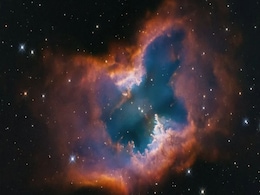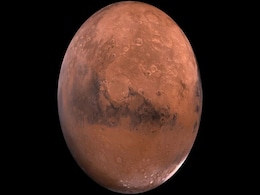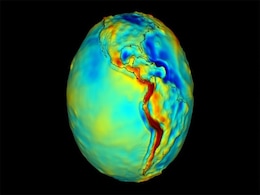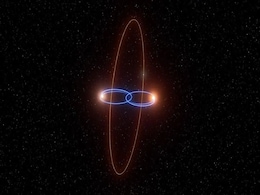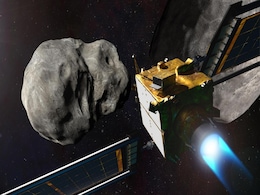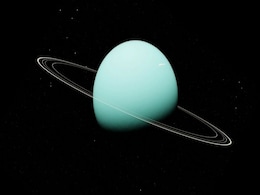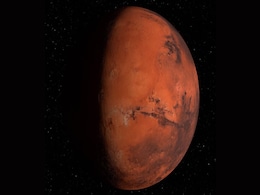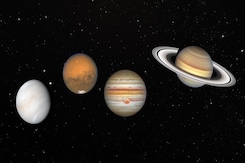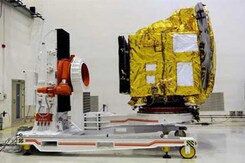Planetary Science
- All
- News
- Videos
-

Hubble Captures Mars, Cosmic Nebulae, and Distant Galaxies in Spectacular 35th Anniversary Photos
- Saturday April 26, 2025
- Written by Gadgets 360 Staff
To celebrate 35 years in orbit, the Hubble Space Telescope has released breathtaking new images of Mars, a planetary nebula, and a distant spiral galaxy. Since its 1990 launch, Hubble has captured nearly 1.7 million observations and continues to awe scientists and stargazers alike with vivid cosmic scenes that reveal the ever-changing beauty of our...
-
 www.gadgets360.com
www.gadgets360.com
-

Water on Ancient Mars? New Study Challenges the Cold Planet Theory
- Saturday April 26, 2025
- Written by Gadgets 360 Staff
Scientists have uncovered compelling evidence suggesting that early Mars was surprisingly wet, featuring extensive networks of lakes and river basins shaped by rainfall and snowfall. This challenges long-held views of a predominantly cold and icy ancient Mars. Despite current climate models struggling to explain sustained liquid water on the Red Pl...
-
 www.gadgets360.com
www.gadgets360.com
-

Rare Planetary Alignment To Form "Smiley Face" In The Sky Next Week. Check Details
- Saturday April 19, 2025
- Science | Edited by Bhavya Sukheja
Stargazers across the globe are in for a treat as a rare triple planetary conjunction is set to light up the skies with a "smiley face" on April 25, Friday.
-
 www.ndtv.com
www.ndtv.com
-

NASA Prepares to Launch First Quantum Sensor for Measuring Gravity from Orbit
- Friday April 18, 2025
- Written by Gadgets 360 Staff
NASA, in collaboration with academia and private companies, is developing the first quantum sensor to map Earth’s gravity from space. Using cold rubidium atoms, the compact instrument will deliver highly sensitive, long-term measurements. This mission could transform how we study Earth’s subsurface and explore planetary bodies across the solar ...
-
 www.gadgets360.com
www.gadgets360.com
-

Bizzare 'Failed Star' Planet Orbiting Double Star System in Milky Way Discovered by Researchers
- Thursday April 17, 2025
- Written by Gadgets 360 Staff
Astronomers have discovered an exoplanet 90 degrees tilted around a special pair of eclipsing brown dwarfs. This uncommon "polar planet" challenges accepted wisdom on planet creation by presenting new insights on the dynamics of binary stars and the range of Milky Way planetary orbits.
-
 www.gadgets360.com
www.gadgets360.com
-

NASA’s James Webb Space Telescope Reveals the Complex Structure of a Planetary Nebula
- Wednesday April 16, 2025
- Written by Gadgets 360 Staff
NASA's James Webb Space Telescope has unveiled the complex character of NGC 1514, a planetary nebula developing over at least 4,000 years. Only seen in infrared light, the nebula's rings now resemble "fuzzy" clusters set in twisted patterns. A network of sharper holes near the centre stars indicates where faster material punched through.
-
 www.gadgets360.com
www.gadgets360.com
-

NASA Shares Planetary Defense Strategy to Protect Earth From Potential Asteroid Strikes
- Tuesday April 15, 2025
- Written by Gadgets 360 Staff
NASA and international scientists closely tracked asteroid 2024 YR4, which initially showed a rare 3 percent collision probability with Earth. Although the threat has now diminished, the incident highlights the importance of asteroid surveillance, open data, and upcoming space missions like NEO Surveyor.
-
 www.gadgets360.com
www.gadgets360.com
-

Scientists Finally Discover How Long a Day Lasts on Uranus
- Saturday April 12, 2025
- Written by Gadgets 360 Staff
Astronomers confirm Uranus’ rotation period using internal oscillation modeling for the first time. On Uranus, a day just lasts far longer. More precise rotational time observations of the gas giant should enable scientists to plan visits to investigate it. Unlike on Mars and Earth, savage windstorms make it far more difficult to identify the rot...
-
 www.gadgets360.com
www.gadgets360.com
-

JWST Captures Unseen Details of Exoplanets in HR 8799 and 51 Eridani Systems
- Thursday April 3, 2025
- Written by Gadgets 360 Staff
The James Webb Space Telescope (JWST) has captured groundbreaking images of exoplanets in the HR 8799 and 51 Eridani systems. By modifying its coronagraphs, astronomers allowed more starlight to pass through, revealing clearer planetary details. The study, published in The Astrophysical Journal Letters, highlights the first successful detection of ...
-
 www.gadgets360.com
www.gadgets360.com
-

Two New Exoplanets Found Orbiting a Star in Draco Constellation
- Wednesday April 2, 2025
- Written by Gadgets 360 Staff
Astronomers have identified two exoplanets, TOI-1453 b and TOI-1453 c, orbiting a star 250 light-years away in Draco. The planets, a super-Earth and a sub-Neptune, were detected using NASA’s TESS satellite and the HARPS-N spectrograph. TOI-1453 b is a rocky planet orbiting close to its star, while TOI-1453 c is twice Earth’s size and may have a...
-
 www.gadgets360.com
www.gadgets360.com
-

James Webb Telescope Captures Neptune’s Auroras in Stunning Detail
- Monday March 31, 2025
- Written by Gadgets 360 Staff
The James Webb Space Telescope has provided the first-ever direct images of Neptune’s auroras, revealing surprising details about the ice giant’s atmosphere. Unlike auroras on Earth, Jupiter, or Saturn, Neptune’s auroras appear across unexpected locations due to its tilted and offset magnetic field. Scientists also detected the presence of H...
-
 www.gadgets360.com
www.gadgets360.com
-

New Study Challenges Claims of Vast Underground Water on Mars
- Thursday March 27, 2025
- Written by Gadgets 360 Staff
Mars’ water history remains a mystery as new research questions the claim that vast amounts of water are stored beneath its surface. A study led by Bruce Jakosky argues that previous estimates of Mars’ mid-crust being saturated with liquid water may be inaccurate. The findings challenge earlier interpretations of seismic data from NASA’s InSi...
-
 www.gadgets360.com
www.gadgets360.com
-

NASA’s EZIE Satellites Begin Mission to Study Auroral Electrojets and Space Weather
- Friday March 21, 2025
- Written by Gadgets 360 Staff
NASA’s Electrojet Zeeman Imaging Explorer (EZIE) mission has been launched aboard a SpaceX Falcon 9 from Vandenberg Space Force Base. The trio of small satellites will map auroral electrojets, powerful currents in Earth’s atmosphere linked to solar storms. Their data will enhance space weather prediction models and help understand planetary mag...
-
 www.gadgets360.com
www.gadgets360.com
-

3D Mapping Reveals 52-Foot Megaripples from Chicxulub Asteroid in Louisiana
- Thursday March 13, 2025
- Written by Gadgets 360 Staff
Massive megaripples, formed by the tsunami after the Chicxulub asteroid impact 66 million years ago, have been mapped deep beneath Louisiana using 3D seismic data. The formations, averaging 52 feet in height and spanning 900 square miles, offer new insights into the force of the ancient tsunami and its global impact. Scientists suggest these findin...
-
 www.gadgets360.com
www.gadgets360.com
-

Mysterious Planetary-Mass Objects May Form in Young Star System Clashes
- Wednesday March 12, 2025
- Written by Gadgets 360 Staff
Recent research challenges traditional views on planetary-mass objects, suggesting they may form through violent interactions between young star systems rather than standard planetary or stellar processes. Simulations indicate these clashes create dense gas filaments that evolve into free-floating objects, often in binary pairs. This discovery expl...
-
 www.gadgets360.com
www.gadgets360.com
-

Hubble Captures Mars, Cosmic Nebulae, and Distant Galaxies in Spectacular 35th Anniversary Photos
- Saturday April 26, 2025
- Written by Gadgets 360 Staff
To celebrate 35 years in orbit, the Hubble Space Telescope has released breathtaking new images of Mars, a planetary nebula, and a distant spiral galaxy. Since its 1990 launch, Hubble has captured nearly 1.7 million observations and continues to awe scientists and stargazers alike with vivid cosmic scenes that reveal the ever-changing beauty of our...
-
 www.gadgets360.com
www.gadgets360.com
-

Water on Ancient Mars? New Study Challenges the Cold Planet Theory
- Saturday April 26, 2025
- Written by Gadgets 360 Staff
Scientists have uncovered compelling evidence suggesting that early Mars was surprisingly wet, featuring extensive networks of lakes and river basins shaped by rainfall and snowfall. This challenges long-held views of a predominantly cold and icy ancient Mars. Despite current climate models struggling to explain sustained liquid water on the Red Pl...
-
 www.gadgets360.com
www.gadgets360.com
-

Rare Planetary Alignment To Form "Smiley Face" In The Sky Next Week. Check Details
- Saturday April 19, 2025
- Science | Edited by Bhavya Sukheja
Stargazers across the globe are in for a treat as a rare triple planetary conjunction is set to light up the skies with a "smiley face" on April 25, Friday.
-
 www.ndtv.com
www.ndtv.com
-

NASA Prepares to Launch First Quantum Sensor for Measuring Gravity from Orbit
- Friday April 18, 2025
- Written by Gadgets 360 Staff
NASA, in collaboration with academia and private companies, is developing the first quantum sensor to map Earth’s gravity from space. Using cold rubidium atoms, the compact instrument will deliver highly sensitive, long-term measurements. This mission could transform how we study Earth’s subsurface and explore planetary bodies across the solar ...
-
 www.gadgets360.com
www.gadgets360.com
-

Bizzare 'Failed Star' Planet Orbiting Double Star System in Milky Way Discovered by Researchers
- Thursday April 17, 2025
- Written by Gadgets 360 Staff
Astronomers have discovered an exoplanet 90 degrees tilted around a special pair of eclipsing brown dwarfs. This uncommon "polar planet" challenges accepted wisdom on planet creation by presenting new insights on the dynamics of binary stars and the range of Milky Way planetary orbits.
-
 www.gadgets360.com
www.gadgets360.com
-

NASA’s James Webb Space Telescope Reveals the Complex Structure of a Planetary Nebula
- Wednesday April 16, 2025
- Written by Gadgets 360 Staff
NASA's James Webb Space Telescope has unveiled the complex character of NGC 1514, a planetary nebula developing over at least 4,000 years. Only seen in infrared light, the nebula's rings now resemble "fuzzy" clusters set in twisted patterns. A network of sharper holes near the centre stars indicates where faster material punched through.
-
 www.gadgets360.com
www.gadgets360.com
-

NASA Shares Planetary Defense Strategy to Protect Earth From Potential Asteroid Strikes
- Tuesday April 15, 2025
- Written by Gadgets 360 Staff
NASA and international scientists closely tracked asteroid 2024 YR4, which initially showed a rare 3 percent collision probability with Earth. Although the threat has now diminished, the incident highlights the importance of asteroid surveillance, open data, and upcoming space missions like NEO Surveyor.
-
 www.gadgets360.com
www.gadgets360.com
-

Scientists Finally Discover How Long a Day Lasts on Uranus
- Saturday April 12, 2025
- Written by Gadgets 360 Staff
Astronomers confirm Uranus’ rotation period using internal oscillation modeling for the first time. On Uranus, a day just lasts far longer. More precise rotational time observations of the gas giant should enable scientists to plan visits to investigate it. Unlike on Mars and Earth, savage windstorms make it far more difficult to identify the rot...
-
 www.gadgets360.com
www.gadgets360.com
-

JWST Captures Unseen Details of Exoplanets in HR 8799 and 51 Eridani Systems
- Thursday April 3, 2025
- Written by Gadgets 360 Staff
The James Webb Space Telescope (JWST) has captured groundbreaking images of exoplanets in the HR 8799 and 51 Eridani systems. By modifying its coronagraphs, astronomers allowed more starlight to pass through, revealing clearer planetary details. The study, published in The Astrophysical Journal Letters, highlights the first successful detection of ...
-
 www.gadgets360.com
www.gadgets360.com
-

Two New Exoplanets Found Orbiting a Star in Draco Constellation
- Wednesday April 2, 2025
- Written by Gadgets 360 Staff
Astronomers have identified two exoplanets, TOI-1453 b and TOI-1453 c, orbiting a star 250 light-years away in Draco. The planets, a super-Earth and a sub-Neptune, were detected using NASA’s TESS satellite and the HARPS-N spectrograph. TOI-1453 b is a rocky planet orbiting close to its star, while TOI-1453 c is twice Earth’s size and may have a...
-
 www.gadgets360.com
www.gadgets360.com
-

James Webb Telescope Captures Neptune’s Auroras in Stunning Detail
- Monday March 31, 2025
- Written by Gadgets 360 Staff
The James Webb Space Telescope has provided the first-ever direct images of Neptune’s auroras, revealing surprising details about the ice giant’s atmosphere. Unlike auroras on Earth, Jupiter, or Saturn, Neptune’s auroras appear across unexpected locations due to its tilted and offset magnetic field. Scientists also detected the presence of H...
-
 www.gadgets360.com
www.gadgets360.com
-

New Study Challenges Claims of Vast Underground Water on Mars
- Thursday March 27, 2025
- Written by Gadgets 360 Staff
Mars’ water history remains a mystery as new research questions the claim that vast amounts of water are stored beneath its surface. A study led by Bruce Jakosky argues that previous estimates of Mars’ mid-crust being saturated with liquid water may be inaccurate. The findings challenge earlier interpretations of seismic data from NASA’s InSi...
-
 www.gadgets360.com
www.gadgets360.com
-

NASA’s EZIE Satellites Begin Mission to Study Auroral Electrojets and Space Weather
- Friday March 21, 2025
- Written by Gadgets 360 Staff
NASA’s Electrojet Zeeman Imaging Explorer (EZIE) mission has been launched aboard a SpaceX Falcon 9 from Vandenberg Space Force Base. The trio of small satellites will map auroral electrojets, powerful currents in Earth’s atmosphere linked to solar storms. Their data will enhance space weather prediction models and help understand planetary mag...
-
 www.gadgets360.com
www.gadgets360.com
-

3D Mapping Reveals 52-Foot Megaripples from Chicxulub Asteroid in Louisiana
- Thursday March 13, 2025
- Written by Gadgets 360 Staff
Massive megaripples, formed by the tsunami after the Chicxulub asteroid impact 66 million years ago, have been mapped deep beneath Louisiana using 3D seismic data. The formations, averaging 52 feet in height and spanning 900 square miles, offer new insights into the force of the ancient tsunami and its global impact. Scientists suggest these findin...
-
 www.gadgets360.com
www.gadgets360.com
-

Mysterious Planetary-Mass Objects May Form in Young Star System Clashes
- Wednesday March 12, 2025
- Written by Gadgets 360 Staff
Recent research challenges traditional views on planetary-mass objects, suggesting they may form through violent interactions between young star systems rather than standard planetary or stellar processes. Simulations indicate these clashes create dense gas filaments that evolve into free-floating objects, often in binary pairs. This discovery expl...
-
 www.gadgets360.com
www.gadgets360.com

